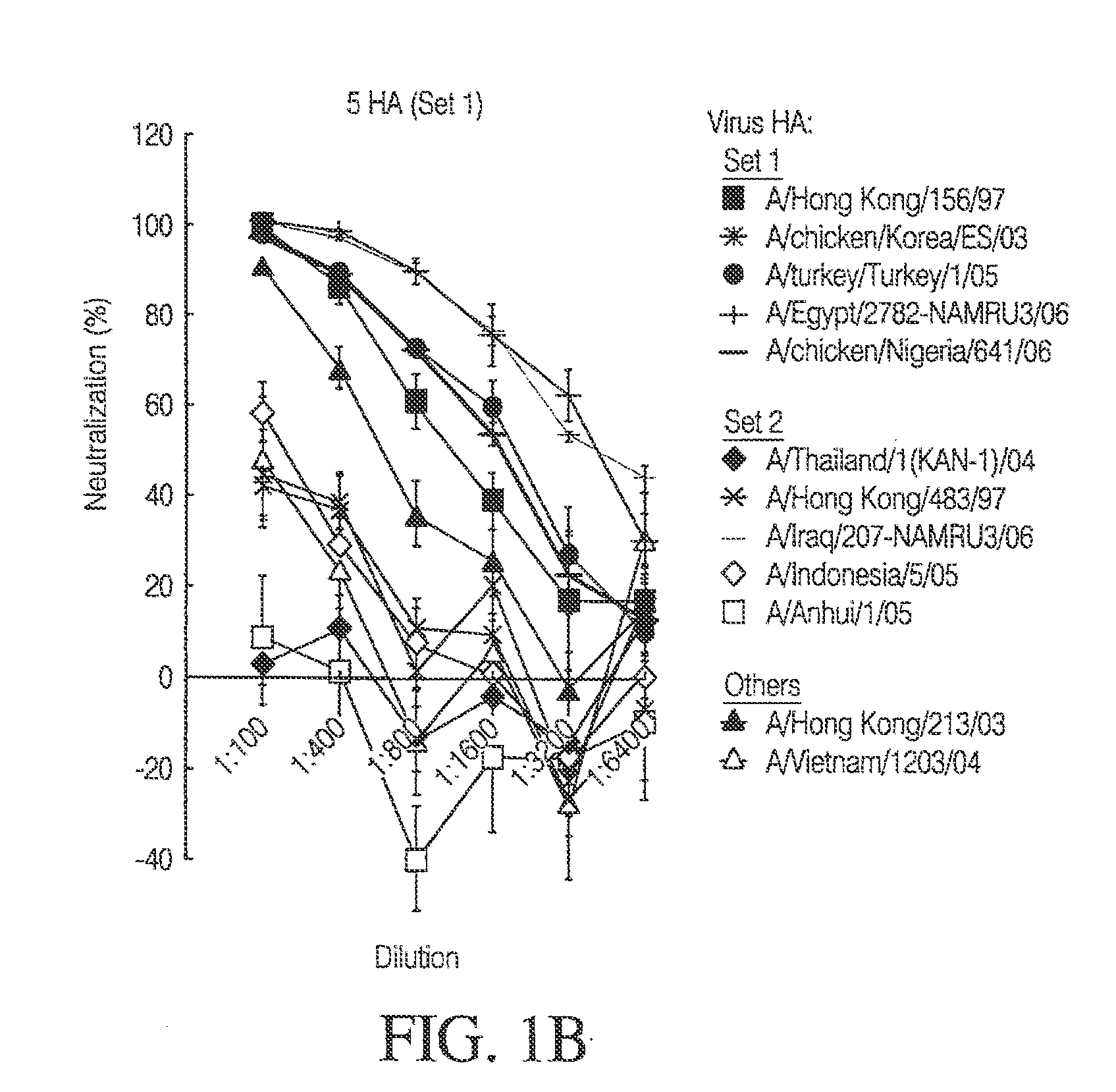Influenza DNA vaccination and methods of use thereof
a technology of inactivated vaccination and dna, which is applied in the field of inactivated vaccination, can solve the problems of causing lethal human infections, unable to fully prevent secondary outbreaks, and affecting the quality of life of people,
- Summary
- Abstract
- Description
- Claims
- Application Information
AI Technical Summary
Problems solved by technology
Method used
Image
Examples
example 1
DNA Constructs
[0134]10 different DNA constructs encoding HA from phylogenetically diverse strains of influenza viruses were generated for experiments in mice. DNA constructs encoding different versions of H5 HA protein including SEQ ID NOs: 1-11 were synthesized using human-preferred codons (GeneArt, Regensburg, Germany). Specifically, the H5 HA proteins include (A / Thailand / 1(KAN-1) / 2004 (clade 1) GenBank AY555150; A / Vietnam / 1203 / 2004 (clade 1) GenBank AY651334; A / Hong Kong / 156 / 1997 (clade 0) GenBank AAC32088; A / Hong Kong / 483 / 1997 GenBank AAC32099.1 (clade 0); A / chicken / Korea / ES / 2003 (clade 2.5) GenBank AAV97603.1; A / Indonesia / 05 / 2005 (clade 2.1.3) ISDN125873; A / turkey / Turkey / 1 / 2005 (clade 2.2) GenBank DQ407519; A / Egypt / 2782-NAMRU3 / 2006 (clade 2.2) GenBank ABE01046; A / chicken / Nigeria / 641 / 2006 (clade 2.2) GenBank DQ406728; A / Iraq / 207-NAMRU3 / 2006 (clade 2.2) GenBank DQ435202; A / Anhui / 1 / 2005 (clade 2.3.4) GenBank ABD28180). HA cDNAs from diverse strains of influenza viruses were then i...
example 2
Univalent HA DNA Vaccination and Response in Mice
[0148]Animals were immunized with each of the 10 different DNA constructs via IM route. 6-8 week old Female BALB / c mice were purchased from The Jackson Laboratory and maintained in the AAALAC accredited Vaccine Research Center Animal Care Facility (Bethesda, Md.) under pathogen-free conditions. All experiments were approved by the Vaccine Research Center Animal Care and Use Committee. The mice were immunized as described in Z.-Y. Yang et al., Nature 428, 561 (2004), herein incorporated by reference in its entirety.
[0149]Mice (10 animals for all test groups, 20 animals for the negative control group) were immunized three times with total 15 μg DNA construct in 100 μl of PBS (pH 7.4) intramuscularly at weeks 0, 3, 6. For the single DNA construct groups, the DNA construct in a volume of 100 μl was administered to each animal: pCMV / R 8κB, pCMV / R 8κB-HA(A / Indonesia / 05 / 2005), pCMV / R-HA(A / Anhui / 1 / 2005), pCMV / R 8κB-HA(A / Thailand / 1(KAN-1) / 2004...
example 3
Multivalent HA Vaccination Response in Mice
[0155]In order to evaluate the ability of mice to generate a potent immune response, a combination of 10 immunogens given at a proportionally lower concentration (1.5 μg per immunogen) was administered intramuscularly to mice as described in Example 2. Similar to the univalent experimental schema, the mice were bled 14 days after the 3rd vaccination.
[0156]FIGS. 1A-C depict the potency of neutralization after 10 HAs multivalent vaccination in mice. Humoral immunity and potency of neutralization were evaluated after vaccination with DNA constructs expressing H5 HA protein, by HA pseudotyped lentiviral inhibition assay. The DNA vaccine consisted of 10 DNA constructs (1.5 μg each) expressing HA proteins from the following 10 different H5 strains indicated by asterisks in the figure: A / Thailand / 1(KAN-1) / 2004; A / Hong Kong / 156 / 1997; A / Hong Kong / 483 / 1997; A / chicken / Korea / ES / 2003; A / Indonesia / 05 / 2005; A / Turkey / Turkey / 1 / 2005; A / Egypt / 2782-NAMRU3 / 2006...
PUM
| Property | Measurement | Unit |
|---|---|---|
| pressures | aaaaa | aaaaa |
| pressure | aaaaa | aaaaa |
| pressure | aaaaa | aaaaa |
Abstract
Description
Claims
Application Information
 Login to View More
Login to View More - R&D
- Intellectual Property
- Life Sciences
- Materials
- Tech Scout
- Unparalleled Data Quality
- Higher Quality Content
- 60% Fewer Hallucinations
Browse by: Latest US Patents, China's latest patents, Technical Efficacy Thesaurus, Application Domain, Technology Topic, Popular Technical Reports.
© 2025 PatSnap. All rights reserved.Legal|Privacy policy|Modern Slavery Act Transparency Statement|Sitemap|About US| Contact US: help@patsnap.com



